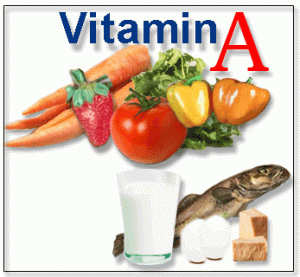There are quite a few vitamins out there, so instead of picking favorites, I decided to go through them in alphabetical order. So, today’s nutrient is vitamin A.
What Is Vitamin A?
 Vitamin A is a fat soluble vitamin. What does this mean? Mix oil and water together and it ends up forming two separate layers. Oil and water doesn’t mix and it’s like that in the human body as well. So, the fat soluble vitamins, like vitamin A, are best absorbed into your body if you eat some fat along with your intake of the vitamin.
Vitamin A is a fat soluble vitamin. What does this mean? Mix oil and water together and it ends up forming two separate layers. Oil and water doesn’t mix and it’s like that in the human body as well. So, the fat soluble vitamins, like vitamin A, are best absorbed into your body if you eat some fat along with your intake of the vitamin.
Vitamin A is a complicated vitamin. It’s actually a family of compounds that includes the retinoids (retinol, retinal, retinoic acid and retinyl esters) and the carotenoids (alpha-carotene, beta-carotene, lutein, astaxanthin and zeaxanthin). The carotenoids are actually a class of approximately 600 organic pigments with provitamin A activity. Most people think of beta-carotene, but as you can see, there are many more carotenoids.
Vitamin A is essential for vision, immune system function, reproduction and cellular communication. It also is vital for healthy hearts, lungs, kidneys and other organs. Did your mom ever tell you to eat your carrots for good eyesight? That isn’t just a wives’ tale. Other foods high in vitamin A include sweet potatoes, beef liver, spinach, cantalope, red sweet peppers, mangos and apricots.
How Much Vitamin A Do We Need?
According to the National Institute of Health, the recommended dietary allowances are:
Recommended Dietary Allowances (RDAs) for Vitamin A
Age Male Female Pregnancy Lactation
0–6 months* 400 mcg RAE 400 mcg RAE
7–12 months* 500 mcg RAE 500 mcg RAE
1–3 years 300 mcg RAE 300 mcg RAE
4–8 years 400 mcg RAE 400 mcg RAE
9–13 years 600 mcg RAE 600 mcg RAE
14–18 years 900 mcg RAE 700 mcg RAE 750 mcg RAE 1,200 mcg RAE
19–50 years 900 mcg RAE 700 mcg RAE 770 mcg RAE 1,300 mcg RAE
51+ years 900 mcg RAE 700 mcg RAE
* Adequate Intake (AI), equivalent to the mean intake of vitamin A in healthy, breastfed infants.
So, what’s an RAE? RAE stands for Retinol Activity Equivalents. It’s rather complex, but sources of vitamin A have different bioactivities. In general, the body converts sources of vitamin A into retinol. 1 mcg of retinol = 12 mcg of beta-carotene = 24 mcg of alpha-carotene or beta-cryptoxanthin. If you consume your vitamin A from dietary supplements, the human body converts 2 mcg of beta-carotene to 1 mcg of retinol. Bottom line, all sources of vitamin A are not equal, so they came up with the RAE measurement so you can measure food stuffs on an equal basis.
You may also see a unit used which is IU, which stands for International Unit. 1 mcg = 3.33 IU. So, if you see 3,000 mcg RAE, it equals 10,000 IU.
What Happens If You Don’t Get Enough?
 Vitamin A deficiency is rare in industrialized nations, but it is common in developing nations. In impoverished areas of the world, vitamin A deficiency is a concern especially for infants, young children and pregnant women. Chronic diarrhea can lead to the excessive loss of vitamin A. A deficiency in this important vitamin is the leading cause of preventable blindness in the world. A deficiency can also increase the severity and risk of death from infections. Deficiencies may also lead to certain types of cancer, age-related macular generation, cataracts and measles.
Vitamin A deficiency is rare in industrialized nations, but it is common in developing nations. In impoverished areas of the world, vitamin A deficiency is a concern especially for infants, young children and pregnant women. Chronic diarrhea can lead to the excessive loss of vitamin A. A deficiency in this important vitamin is the leading cause of preventable blindness in the world. A deficiency can also increase the severity and risk of death from infections. Deficiencies may also lead to certain types of cancer, age-related macular generation, cataracts and measles.
What Happens If You Get Too Much?
Since vitamin A is a fat-soluble vitamin, it can be stored in the body, primarily in the liver, where it can build to toxic levels. Eating too much vitamin A over a long period of time can lead to dizziness, nausea, increased intercranial pressure, headaches, skin irritation, pain in joints and bones, coma and death. Excess vitamin A can also lead to reduced bone mineral density, which can then lead to the increased risk of bone fractures. If you live in an artic area, eating polar bear liver can lead to a sudden and massive rise in vitamin A blood levels. Most vitamin A overconsumption comes from supplemental vitamins.
The Tolerable Upper Intake Levels for vitamin A are below:
Tolerable Upper Intake Levels (ULs) for Preformed Vitamin A
Age Male Female Pregnancy Lactation
0–3 years 600 mcg RAE 600 mcg RAE
4–8 years 900 mcg RAE 900 mcg RAE
9–13 years 1,700 mcg RAE 1,700 mcg RAE
14–18 years 2,800 mcg RAE 2,800 mcg RAE 2,800 mcg RAE 2,800 mcg RAE
19+ years 3,000 mcg RAE 3,000 mcg RAE 3,000 mcg RAE 3,000 mcg RAE
Interactions With Medicines
Vitamin A can interact with certain medications, such as those taken for weight-loss, psoriasis, and lymphoma. Please consult your physician if you have any concerns about vitamin-medicine interactions.
Bottom Line
The best way to consume any nutrient in order to avoid over-consumption is to obtain your vitamins from foods. The best way to consume enough of any nutrient is to eat according to MyPlate, and eat a variety of foods in a variety of colors.
Until next time, remember that… there are no excuses when it comes to your health!
Pingback: Pick up the paramount nutrient from vitamins.
Thanks for the nice blog. It was very useful for me. Keep sharing such ideas in the future as well. This was actually what I was looking for, and I am glad to came here! Thanks for sharing the such information with us